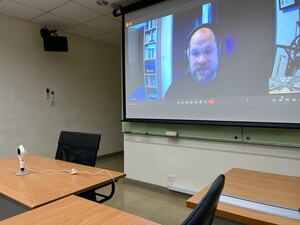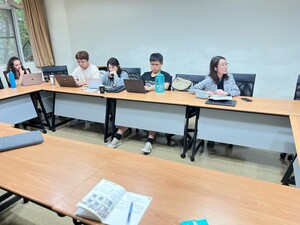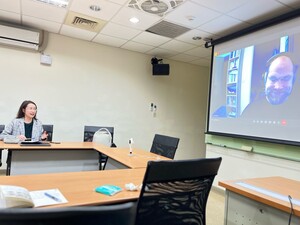IMICS Guest Lecture Featuring ‘Changing Norms and Infrastructures of Conflict Reporting’



Date :
2024-01-19
Department :
International Master's Program in International Communication Studies
【Article by IMICS】
On December 13th Dr Stupart, a lecturer in Department of Communication and Media, University of Liverpool, discussed the changing nature of conflict reporting in the Emerging Media and the News course.
Based on his research on journalistic witnessing in South Sudan, Dr Stupart discussed the shift in conflict journalism, and considered three questions, including ‘Why now?’ ‘How come?’ ‘What is the future of journalism?’
Driven by their passion for war coverage, journalists working in conflict zones risk death, such as the death of Marie Colvin during her reporting on the Syrian civil war. Regarding research on conflict reporting, Dr Stupart found that the focus has shifted toward examining the role of journalists in conflict zones. More specifically he pointed out that journalists have prioritized a humanitarian role.
Encountering economic difficulty, news industries nowadays tend to cut down on their cost of hiring foreign correspondents. Against such a backdrop, journalists covering conflicts mostly work freelance. Without sufficient organizational support and resources, many journalists in conflict zones increasingly rely on humanitarian networks. Dr Stupart observed that journalists have become less socialized through newsrooms.
Dr Stupart further argued that journalists reporting on conflicts nowadays are living, socializing, and hanging out in ‘Aidland’, first coined by Raymond Apthorpe.
“Aidland is the trail of where foreign aid comes from, where it goes, and what then.” - Raymond Apthrope, 2005.
However, Dr Stupart found that Aidland is not available in all conflicts, such as those taking place in Gaza and Ukraine.
Besides the issue of Aidland, Dr Stupart also pointed out that the future of conflict journalism remains uncertain. In addition to changes in the field of journalism, including a continued decrease in economic resources and a trend towards a humanitarian way of news reporting, new developments in conflicts such as increasing lethality of wars and therefore limited access to humanitarian space all lead to uncertainty surrounding conflict journalism.
In the question-and-answer session, Sonia, a first-year student of IMICS, and Dr Yu asked how humanitarian practice looks like in conflict coverage. Dr Stupart referred to the idea of ‘journalism of attachment’ proposed by Martin Bell who worked for the BBC during the war in Yugoslavia. It is argued that journalists should not adhere to an objective style of news reporting but to morally attach to their reports. Although this idea was heavily criticized back then, it has become acceptable. Using moralized language to make claims in news coverage is no longer controversial. This is a telling example of the humanitarian turn in conflict journalism.
On December 13th Dr Stupart, a lecturer in Department of Communication and Media, University of Liverpool, discussed the changing nature of conflict reporting in the Emerging Media and the News course.
Based on his research on journalistic witnessing in South Sudan, Dr Stupart discussed the shift in conflict journalism, and considered three questions, including ‘Why now?’ ‘How come?’ ‘What is the future of journalism?’
Driven by their passion for war coverage, journalists working in conflict zones risk death, such as the death of Marie Colvin during her reporting on the Syrian civil war. Regarding research on conflict reporting, Dr Stupart found that the focus has shifted toward examining the role of journalists in conflict zones. More specifically he pointed out that journalists have prioritized a humanitarian role.
Encountering economic difficulty, news industries nowadays tend to cut down on their cost of hiring foreign correspondents. Against such a backdrop, journalists covering conflicts mostly work freelance. Without sufficient organizational support and resources, many journalists in conflict zones increasingly rely on humanitarian networks. Dr Stupart observed that journalists have become less socialized through newsrooms.
Dr Stupart further argued that journalists reporting on conflicts nowadays are living, socializing, and hanging out in ‘Aidland’, first coined by Raymond Apthorpe.
“Aidland is the trail of where foreign aid comes from, where it goes, and what then.” - Raymond Apthrope, 2005.
However, Dr Stupart found that Aidland is not available in all conflicts, such as those taking place in Gaza and Ukraine.
Besides the issue of Aidland, Dr Stupart also pointed out that the future of conflict journalism remains uncertain. In addition to changes in the field of journalism, including a continued decrease in economic resources and a trend towards a humanitarian way of news reporting, new developments in conflicts such as increasing lethality of wars and therefore limited access to humanitarian space all lead to uncertainty surrounding conflict journalism.
In the question-and-answer session, Sonia, a first-year student of IMICS, and Dr Yu asked how humanitarian practice looks like in conflict coverage. Dr Stupart referred to the idea of ‘journalism of attachment’ proposed by Martin Bell who worked for the BBC during the war in Yugoslavia. It is argued that journalists should not adhere to an objective style of news reporting but to morally attach to their reports. Although this idea was heavily criticized back then, it has become acceptable. Using moralized language to make claims in news coverage is no longer controversial. This is a telling example of the humanitarian turn in conflict journalism.
